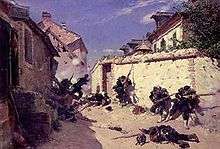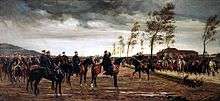Siege of Metz (1870)
The Siege of Metz lasting from 19 August – 27 October 1870 was fought during the Franco-Prussian War and ended in a decisive Allied German victory.
| Siege of Metz | |||||||||
|---|---|---|---|---|---|---|---|---|---|
| Part of the Franco-Prussian War | |||||||||
.jpg) One of the Metz forts under German occupation after the French surrender | |||||||||
| |||||||||
| Belligerents | |||||||||
|
|
| ||||||||
| Commanders and leaders | |||||||||
|
|
| ||||||||
| Units involved | |||||||||
|
elements of | Army of the Rhine | ||||||||
| Strength | |||||||||
|
Initially: 168,435[1] 642 field guns[1] September: 197,326 |
Initially: 154,481[1] 694 field guns[1] 2,876 fortress guns | ||||||||
| Casualties and losses | |||||||||
|
5,740 killed and wounded 40,000 sick |
193,000 men, 622 field guns, 2,876 fortress guns, 72 mitrailleuses, 260,000 rifles captured | ||||||||
The French Army of the Rhine under François Bazaine retreated into the Metz fortress after its defeat by the Germans at the Battle of Gravelotte on 18 August 1870. The fortress was promptly surrounded by German forces under Prince Friedrich Karl of Prussia. The French Army of Châlons was sent to relieve the Army of the Rhine but was itself encircled and annihilated by the German armies at the Battle of Sedan on 1–2 September.
Unable to capture the fortress by bombardment or storm, the besieging Germans resorted to starving the French to submission. Attempted French breakouts ended in defeat at the battles of Noisseville on 31 August–1 September and Bellevue on 7 October. French food supplies ran out on 20 October and Bazaine surrendered the fortress and the entire Army of the Rhine, some 193,000 men, into German hands on 27 October.
The annihilation of the French Army of the Rhine freed Prince Friedrich Karl's armies for operations against French forces in the Loire river valley for the rest of the war. Metz was annexed into the German Empire after the signing of the Treaty of Frankfurt on 10 May 1871.
Background
After being held at the Battle of Gravelotte, Marshal Bazaine retreated into the defenses of Metz. There he was besieged by over 150,000 Prussian troops of the First and Second Armies on 19 August.[2][3]
Prelude
Napoleon III and Marshal Patrice de MacMahon formed the new French Army of Châlons, to march on to Metz to rescue Bazaine. Napoleon III personally led the army with Marshal MacMahon in attendance. The Army of Châlons marched north-east towards the Belgian border to avoid the Prussians before striking south to link up with Bazaine. The Prussians, under the command of Field Marshal Count Helmuth von Moltke, took advantage of this maneuver to catch the French in an encirclement. He left the Prussian First and Second Armies besieging Metz, except three corps detached to form the Army of the Meuse under the Crown Prince of Saxony. With this army and the Prussian Third Army, Moltke marched northward and caught up with the French at Beaumont on 30 August. After a sharp fight in which they lost 5,000 men and 40 cannons, the French withdrew toward Sedan. Having reformed in the town, the Army of Châlons was immediately isolated by the converging Prussian armies. Napoleon III ordered the army to break out of the encirclement immediately. With MacMahon wounded on the previous day, General Auguste Ducrot took command of the French troops in the field. The Army of Châlons was trapped and destroyed at the Battle of Sedan.[4]
Siege

The French calculated they had enough food for 70,000 civilians for three and a half months and five months worth of provisions for a regular garrison. Because the entire Army of the Rhine was stuck in the fortress, there were only enough provisions for 41 days and oats for 25 days.[5] The Germans brought up 50 heavy siege guns from Germany to bombard Metz, but the fortress was too heavily stocked with artillery and well-built for it to be taken with the means available to the Germans. Unable to silence the fortress guns sufficiently to conduct siege operations, the besiegers opted to starve out the trapped French army. By September, about 25% of the 197,326-strong German siege force still lacked proper accommodations and the sick list in military hospitals grew to 40,000 men. The Germans supplemented their meat rations with tinned food. The French situation was much worse, with riots breaking out among the starving army and city.[5][6]
The French attempted to break the siege first at Noisseville on 31 August–1 September and again at Bellevue on 7 October but were repulsed each time. Each side lost about 5,000 men killed and wounded in total in these two breakout attempts.[1]
On 20 October, the food provisions of the fortress ran out and the French Army of the Rhine subsisted afterward on the flesh of 20,000 horses, which were consumed at a rate of 1,000 per day.[7] Bazaine was forced to surrender his entire army on 27 October because of starvation.[3][8] The Prussians offered the honors of war to the defeated French army, but, contrary to usual practice, Bazaine refused the honor.[9]
On 29 October, Prussian flags were raised on Metz's outworks and the French Army of the Rhine marched out silently, and in good order. They were taken prisoner by a Prussian Corps at each gate, put into bivouacs and supplied with food. The Germans allowed the French officers to keep their swords and remain in Metz, which was largely unharmed by the siege. The Germans immediately sent a train of food and live cattle to the city they had just conquered.[10] The French prisoners were sent by way of Saarbrücken and Trier to prisoners of war camps, guarded by Landwehr battalions. Bazaine was sent as a captive to Kassel. The German 26th Brigade was stationed as the Metz garrison, with General von Kummer as commandant.[10][7] Dead horses, unburied corpses and burnt or putrefying refuse greeted the German conquerors on their entry, a testament to the suffering the French had endured.[10]
Aftermath

Prince Friedrich Karl and the Prussian Second Army were now free to move against the French force in the Loire River area. The siege is commemorated by the "Siegesmarsch von Metz" which uses parts of the "Die Wacht am Rhein". One notable figure present on the Prussian side was the prominent philosopher Friedrich Nietzsche, who served as a medical attendant. Nietzsche contracted both diphtheria and dysentery during the siege, worsening his already poor state of health.[11]
Casualties
The French lost 167,000 enlisted men and 6,000 officers taken to POW camps on 27 October, as well as 20,000 sick who temporarily stayed behind in Metz.[10][7] Material losses were enormous and amounted to 622 field guns, 2,876 fortress guns, 72 mitrailleuses, 137,000 chassepots, 123,000 other small arms, vast stores of ammunition and 56 Imperial Eagles, all captured by the Germans.[10][7] The Germans lost 5,500 enlisted men and 240 officers killed and wounded, as well as large numbers of sick.[10][7]
Citations
- Clodfelter 2017, p. 185.
- Michael Howard, The Franco Prussian War ISBN 0-415-26671-8
- Fortescue 2001, p. 9.
- German General Staff 1880, p. 177.
- Moltke 1892, p. 160.
- Moltke 1892, p. 161.
- Moltke 1892, p. 166.
- Article on F. Bazaine in Encyclopædia Britannica
- Howard 1991, p. 223.
- German General Staff 1880, p. 201.
- http://plato.stanford.edu/entries/nietzsche/
References
- Clodfelter, M. (2017). Warfare and Armed Conflicts: A Statistical Encyclopedia of Casualty and Other Figures, 1492-2015 (4th ed.). Jefferson, North Carolina: McFarland. ISBN 978-0786474707.CS1 maint: ref=harv (link)
- Fortescue, W. (2001) [2000]. The Third Republic in France, 1870-1940: Conflicts and continuities. ISBN 0-415-16944-5.CS1 maint: ref=harv (link)
- German General Staff (1880). The Franco-German War 1870-71: Part 2; Volume 1. London: Clowes & Sons.CS1 maint: ref=harv (link)
- Howard, M. (1991). The Franco-Prussian War: The German Invasion of France 1870–1871. New York: Routledge. ISBN 0-415-26671-8.CS1 maint: ref=harv (link)
- Moltke, H. (1892). The Franco-German War of 1870-71. New York: Harper.CS1 maint: ref=harv (link)